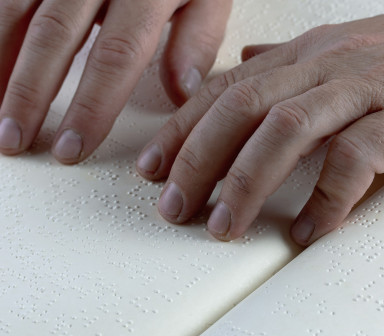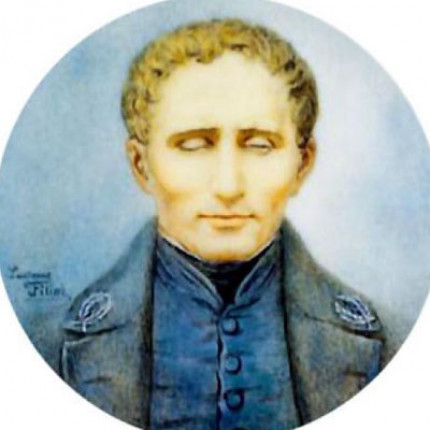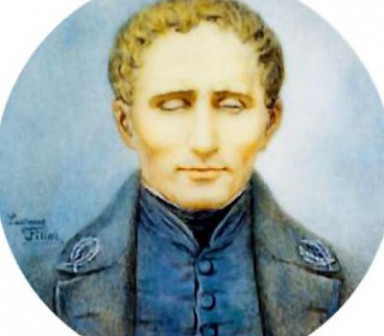Braille is a tactile system that allows blind and partially sighted people to access literacy by reading and writing.
Braille is read by touch, by using the pads of the fingers to feel the letters and symbols. Braille can be written in a variety of ways; using specialist equipment or specific computer software.
Braille is available in nearly every language and is used all over the world. In Scotland, we use the Unified English Braille (UEB) code.

Who uses braille?
Braille is typically used by blind, partially sighted and deafblind people. It is possible to learn braille at any age. Braille is hugely important to blind and visually impaired people as method of accessing literacy and has the potential to promote intellectual freedom, equal opportunity and personal security.
Teaching braille to young children is important because it is a much better way to help them understand concepts related to spelling, punctuation and grammar than simply listening to audio books. In the case of adapted print readers, braille is considered in situations where a functional vision and media assessment indicates that a pupil’s use of print is challenged and is making it difficult for the pupil to keep up with academic work. Teachers and others who are not visually impaired tend to read braille by sight rather than by touch. Parents who have a child with a visual impairment often choose to learn braille alongside their child. In Scotland, specialist teachers who teach braille are called Qualified Teachers of the Visually Impaired (QTVI).
Who invented braille?
Braille was developed by Louis Braille in France the 1820s. His code continues to have a huge impact on the lives of blind and partially sighted people 200 years later. Learn more about Louis Braille and his achievements.

How are braille symbols formed?
Braille symbols are formed within units of space known as braille cells. A full braille cell consists of six raised dots arranged in two parallel vertical columns of three dots (like the number six on a dice or a domino). The dot positions are identified by numbers one through to six. 64 combinations are possible using one or more of these six dots, including the completely full and the completely empty cell. Combinations of dots within the cells are used to represent individual letters, numbers, punctuation signs, groups of letters or even a whole words. Braille is usually read with the index, or first, finger of one or both hands.
Uncontracted braille
When every letter of every word, punctuation mark and number is expressed in braille, it is called uncontracted braille. People who are learning braille will usually start out with uncontracted braille. Books and documents can be translated into uncontracted braille, but these tend to become quite large and bulky as uncontracted braille takes up more space on a page.
For some children and adults, there may be particular reasons why learning only uncontracted braille is appropriate. For most people using braille, especially children who are learning literacy via the medium of braille, the code is introduced in a unique sequential order, progressing naturally from uncontracted to contracted braille as learners progress through their chosen braille reading scheme.
Contracted braille
Contracted braille uses cells individually or in combination with others to form a variety of contractions which represent specific groups of letters or whole words, like a sort of shorthand. There are 180 different letter contractions and 75 shortform words used in the contracted Unified English Braille (UEB) code.
Contracted braille has its advantages, in particular for use with longer reading material, as it helps to speed up reading. From a production perspective, contracted braille takes up less room on a page than uncontracted braille, requiring less paper and therefore reducing the bulkiness and cost of some embossed braille materials. Contracted braille is therefore used most often for books and publications.
Here are some examples of the type of sentences that you might find in an early contracted braille reading book for children:
I DO LIKE THAT cat BUT I LIKE THAT dog too.
The words DO, LIKE, THAT, BUT, LIKE and THAT are all known as Alphabetic Wordsigns, where one letter of the alphabet is used in braille to represent a whole word. D=DO; L=LIKE; T=THAT; B=BUT
I HAVE a GOOD LITTLE dog.
The word HAVE is an Alphabetic Wordsign. The words GOOD and LITTLE are known as Shortforms, where individual words have special braille abbreviations. GD=GOOD; LL=LITTLE
I LIKE THE LITTLE cat AND THE big dog.
The word LIKE is an Alphabetic Wordsign. LITTLE is a Shortform. The words AND and THE are known as Wordsign Contractions, where a specific combination of dots in one braille cell resents a whole word. L=LIKE; LL=LITTLE; dots 1,2,3,4,6=AND; dots 1,2,4,6=THE
How is braille written?
Braille can be written on paper using a Perkins Brailler™ which produces embossed braille directly onto a page. Unlike a typewriter, a Perkins Brailler™ has just six keys and a space bar for writing. The keys correspond with the six dots of a braille cell. The user presses single or multiple keys at the same time to write letters, words, numbers or mathematical or music symbols. There are additional keys for backspace and advancing onto a new line.
Handheld braille labelling machines can produce sticky labels with words written in braille, which can be used to label items. Knowledge of braille is not needed for using these machines.
Digital assistive technology provides further means for blind and visually impaired people to utilise braille in daily life. Electronic braille notetakers serve as braille word processors and also possess the functionality of a smartphone or tablet. These devices not only enable users to complete written work tasks, but also produce hard copies of their work in either braille or print. Additionally, these devices enable users to send and receive emails, browse the internet and read or listen to digital books using a combination of the refreshable braille display and speech output. There are also stand-alone electronic refreshable braille displays. Both these and braille notetakers can be linked to a PC or laptop with screen reading software enabled to create a multi-functional braille-based IT setup.
Maths and music notations
Louis Braille created braille music notation at the same time as he devised the literary braille code. It uses the same six dot configuration to represent notes, pitch and rhythm. Braille music must be read first and memorised as it’s not possible to read braille music and play an instrument at the same time.
There is also a separate technical braille code for mathematical and scientific symbols.
Is braille difficult to learn?
In the same way that mastering print reading and writing requires sequential learning and practise so, too, does braille. For a young child learning braille, there are particular pre-braille skills that are useful to have in preparation for beginning to learn to read and write braille. These skills include but are not limited to fine motor, tactile discrimination, spatial awareness and auditory awareness. With a carefully tailored, child-centred approach young braille learners can progress to become fluent readers.
The Royal Blind School teaches blind and visually impaired children and young people to read and write braille. At the school, pupils start to learn braille by embarking on a pre-braille programme tailored to meet individual pupil needs. They then progress to learning braille, using a dedicated progressive braille reading scheme. Pupils learn to write, alongside reading, first using a Perkins Brailler and then progressing on to digital electronic braille devices.
